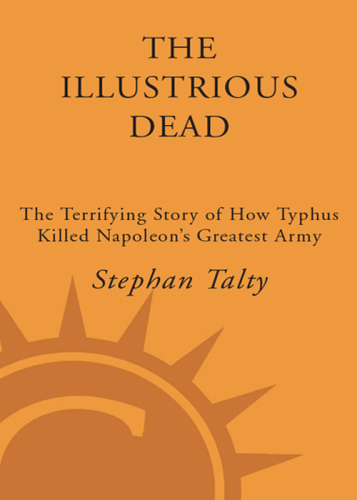
The Illustrious Dead
The Terrifying Story of How Typhus Killed Napoleon's Greatest Army
- اطلاعات
- نقد و بررسی
- دیدگاه کاربران
نقد و بررسی

April 20, 2009
When Napoleon invaded Russia in 1812, typhus ravaged his army, killing hundreds of thousands and ensuring his defeat, according to this breathless combination of military and medical history. After summarizing the havoc this disease wreaked on earlier armies and sketching Napoleon’s career, the book describes his invasion of Russia with more than 600,000 men. Almost immediately typhus struck. Infected lice excrete the microbe in their feces, and victims acquire the disease by scratching the itchy bite. Talty (Mulatto America
) describes the effects in graphic detail: severe headache, high fever, delirium, generalized pain and a spotty rash. Death may take weeks, and fatalities approached 100% among Napoleon’s increasingly debilitated, filthy, half-starved soldiers. Talty makes a good case that it was typhus, not “General Winter,” that crushed Napoleon. Readers should look elsewhere for authoritative histories of Napoleon’s wars and of infectious diseases, but Talty delivers a breezy, popular account of a gruesome campaign, emphasizing the equally gruesome epidemic that accompanied it. 12 maps.

April 1, 2009
Journalist Talty (Empire of Blue Water: Captain Morgan's Great Pirate Army, the Epic Battle for the Americas, and the Catastrophe That Ended the Outlaws' Bloody Reign, 2007, etc.) examines how typhus became the primary killer in Napoleon's disastrous 1812 invasion of Russia.
Drawing on the legions of soldiers from nations that he had conquered, Napoleon had amassed a huge army by the spring of 1812—690,000 strong, Talty estimates. Alexander I of Russia, in contrast, had only about 162,000 on the front line. Driven by"dry calculation" and the need for fresh victories, Napoleon and his troops crossed the Niemen River on June 24, and were soon struck by an ancient microbe transmitted by the common body louse. By the attack on Smolensk in mid-August, Napoleon's effective fighting force was reduced to 175,000, with the vanishing of the army attributed more to deprivation and the heat than to the dreaded"war fever." After the bloodbath of Borodino in early September, the hospitals for the sick and wounded became incubators for the epidemic, even though, notes Talty,"a germ theory of disease had been in place for almost two hundred years." Retreating from Moscow in November, Napoleon had lost nearly 400,000 men, as many as 200,000 from disease. By the time the army limped back into Germany, there were only a few thousand left, who would go on to infect their homes as"fatal messengers" of the doomed Russian campaign. Talty speculates on the outcome if typhus had not ravaged Napoleon's forces, and shows how French doctor Charles Nicolle's isolation of its transmission helped avert the decimation of European troops in World War I.
Dark, intriguing military history.
(COPYRIGHT (2009) KIRKUS REVIEWS/NIELSEN BUSINESS MEDIA, INC. ALL RIGHTS RESERVED.)

Starred review from May 1, 2009
As much a history of typhus as it is a history of Napoleon's invasion of Russia, this book presents both subjects in graphic detail, leaving the reader with no illusions of the "glory" of 19th-century warfare. In the spring of 1812, Napoleon assembled the largest army seen in Europe up to that time for the invasion and conquest of Russia690,000 men under arms, most of whom would actually cross into Russian territory, followed by approximately 50,000 civilians. That's more people than lived then in Paris; this moving population would have ranked as the fifth-largest city in the world. Some 500,000 of them would never return, less than a quarter of them dying as a result of combat; the reason for most of the deaths is the subject of this book. Using contemporary sources, Talty ("Empire of Blue Water") presents the whole horrifying experience as lived by the common soldier, the doctors, and officers up the ranks to the generals. He makes his case for the typhus being transmitted by the body louse. Strangely enough, the disease was no longer prevalent in Europe after 1814. Strongly recommended. [See Prepub Alert, "LJ" 2/15/09.].David Lee Poremba, Winderemere, FL
Copyright 2009 Library Journal, LLC Used with permission.

June 1, 2009
Talty is very informative, even witty, on a grim topic: how typhus abetted Napol'ons defeat when he invaded Russia. Talty interweaves accounts of Napol'ons preparations for the invasion and subsequent battles and sections on the history of typhus. He quotes observations made in Europe since the late Middle Ages, when typhus was first described as a specific disease. His pacing is excellent, and he is a very visual writer who brings readers sensorily into the situations of the great armys officers, men, and physicians as they cross the Russian frontier, start giving battle, and fall ill and die without knowing why. He clearly describes the state of very early nineteenth-century medical knowledge and how it helped or hindered Napol'ons campaign. After a vivid account of the debacle of 1812, Talty finishes with the story of the discovery of the typhus vector at the beginning of the twentieth century and the diseases effects in various countries since, the last of which rouses fear comparable to that of 1812. Highly recommended for both content and style.(Reprinted with permission of Booklist, copyright 2009, American Library Association.)




دیدگاه کاربران